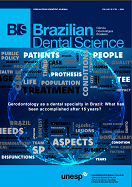Collagen IV and laminin expression in squamous cell carcinomas of lower lip and tongue
DOI:
https://doi.org/10.14295/bds.2016.v19i2.1240Abstract
Objective: In this study, the expression of the extracellular matrix proteins was immunohistochemically studied and compared with the histological grading of squamous cell carcinomas of the lower lip and tongue. Material and Methods: The lower lip carcinomas (n=12) and the tongue carcinomas (n=12) were histopathologically graduated according to Bryne’s method. The immunohistochemical technique utilized specific antibodies to collagen IV and laminin. Histopathologic and immunohistochemical analysis were carried-out on the tumoral invasive front. Results: Most of lower lip carcinomas (91.7%) was classified in lower score and all tongue carcinomas (100%) in high score malignant grade (p<0.01). Collagen type IV expression was absent in the peritumoral basement membrane in 50% of lower lip carcinomas and in 66.7% of tongue carcinomas (p=0.09). Laminin expression was absent in the peritumoral basement membrane in 66.7% of lower lip carcinomas and in 58.3% of tongue carcinomas (p=0.48). When these two glicoproteins were expressed, they showed a linear, thin and discontinuous pattern and a weak intensity of expression. Conclusion: The high score malignancy grade of the tongue carcinomas associated with the expression pattern of the studied matrix proteins. It suggests that tongue squamous cell carcinomas have more invasive potential and more aggressive biological behavior than the lower lip carcinomas.
Keywords
Collagen type IV; Laminin; Carcinoma; Immunohistochemistry.
Downloads
Downloads
Published
How to Cite
Issue
Section
License
Brazilian Dental Science uses the Creative Commons (CC-BY 4.0) license, thus preserving the integrity of articles in an open access environment. The journal allows the author to retain publishing rights without restrictions.
=================




























